Using Numeracy data and IT
VerifiedAdded on 2023/06/17
|19
|3337
|181
AI Summary
This guide covers the basics of using Numeracy data and IT. It includes topics such as fractions, equivalent fractions, simplification, computing, data analysis, and more. The guide also provides examples and explanations to help readers understand the concepts better. Subject: Numeracy, IT | Course Code: NA | Course Name: NA | College/University: NA
Contribute Materials
Your contribution can guide someone’s learning journey. Share your
documents today.
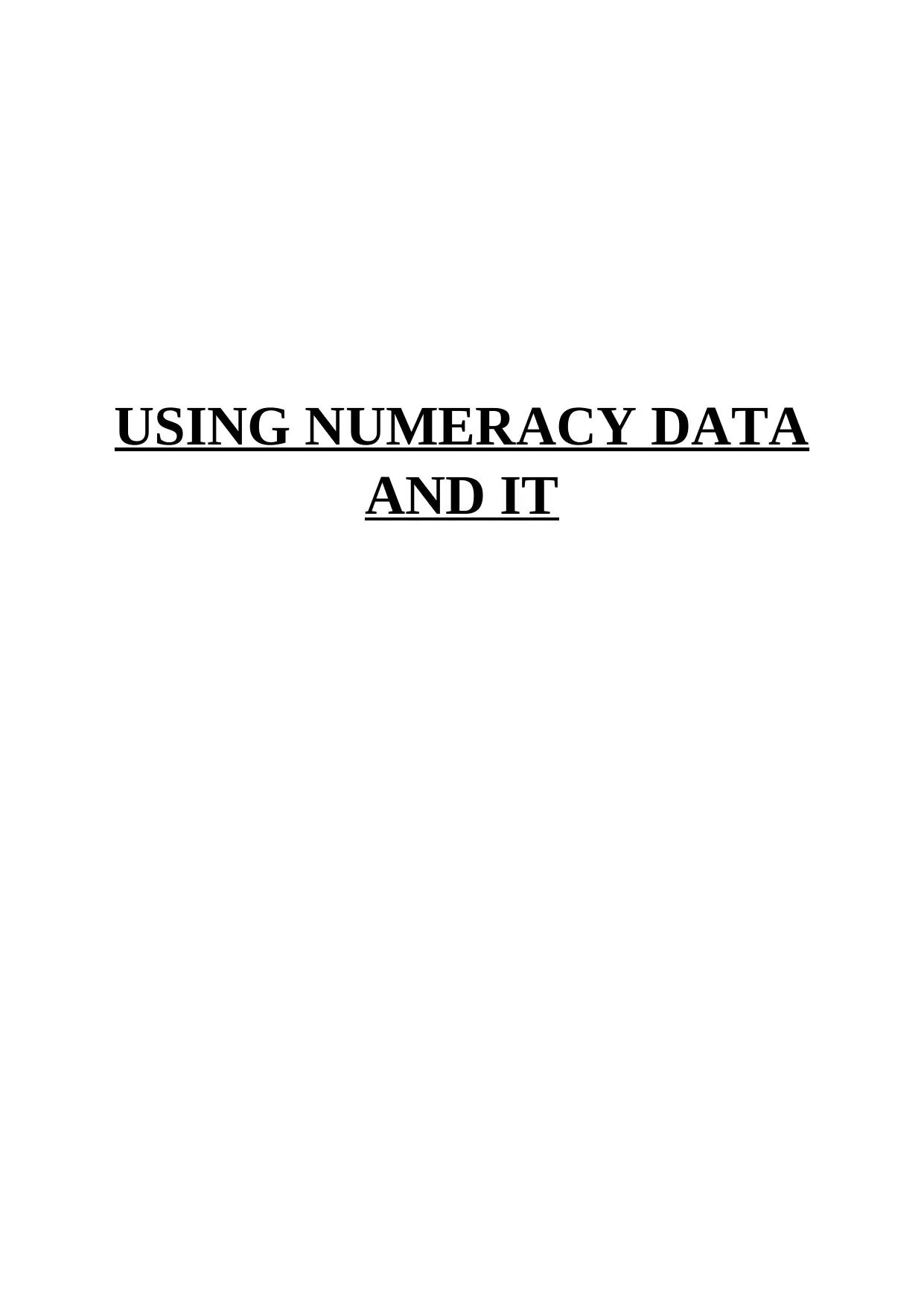
USING NUMERACY DATA
AND IT
AND IT
Secure Best Marks with AI Grader
Need help grading? Try our AI Grader for instant feedback on your assignments.


Table of Contents
PART 1 – Using Numeracy.......................................................................................................3
Q – 1.......................................................................................................................................3
Q – 2.......................................................................................................................................3
Q – 3.......................................................................................................................................3
Q – 4.......................................................................................................................................4
Q – 4.......................................................................................................................................4
Q – 5.......................................................................................................................................4
Q – 6.......................................................................................................................................4
Q – 7.......................................................................................................................................4
Q – 8.......................................................................................................................................4
Q – 9.......................................................................................................................................5
Q – 10.....................................................................................................................................5
PART – 2: Using data................................................................................................................5
PART - 3: Using IT....................................................................................................................8
Q – 12.....................................................................................................................................8
Q – 13.....................................................................................................................................8
Q – 14...................................................................................................................................10
Q – 15...................................................................................................................................12
Q – 16...................................................................................................................................16
REFERENCES.........................................................................................................................18
PART 1 – Using Numeracy.......................................................................................................3
Q – 1.......................................................................................................................................3
Q – 2.......................................................................................................................................3
Q – 3.......................................................................................................................................3
Q – 4.......................................................................................................................................4
Q – 4.......................................................................................................................................4
Q – 5.......................................................................................................................................4
Q – 6.......................................................................................................................................4
Q – 7.......................................................................................................................................4
Q – 8.......................................................................................................................................4
Q – 9.......................................................................................................................................5
Q – 10.....................................................................................................................................5
PART – 2: Using data................................................................................................................5
PART - 3: Using IT....................................................................................................................8
Q – 12.....................................................................................................................................8
Q – 13.....................................................................................................................................8
Q – 14...................................................................................................................................10
Q – 15...................................................................................................................................12
Q – 16...................................................................................................................................16
REFERENCES.........................................................................................................................18
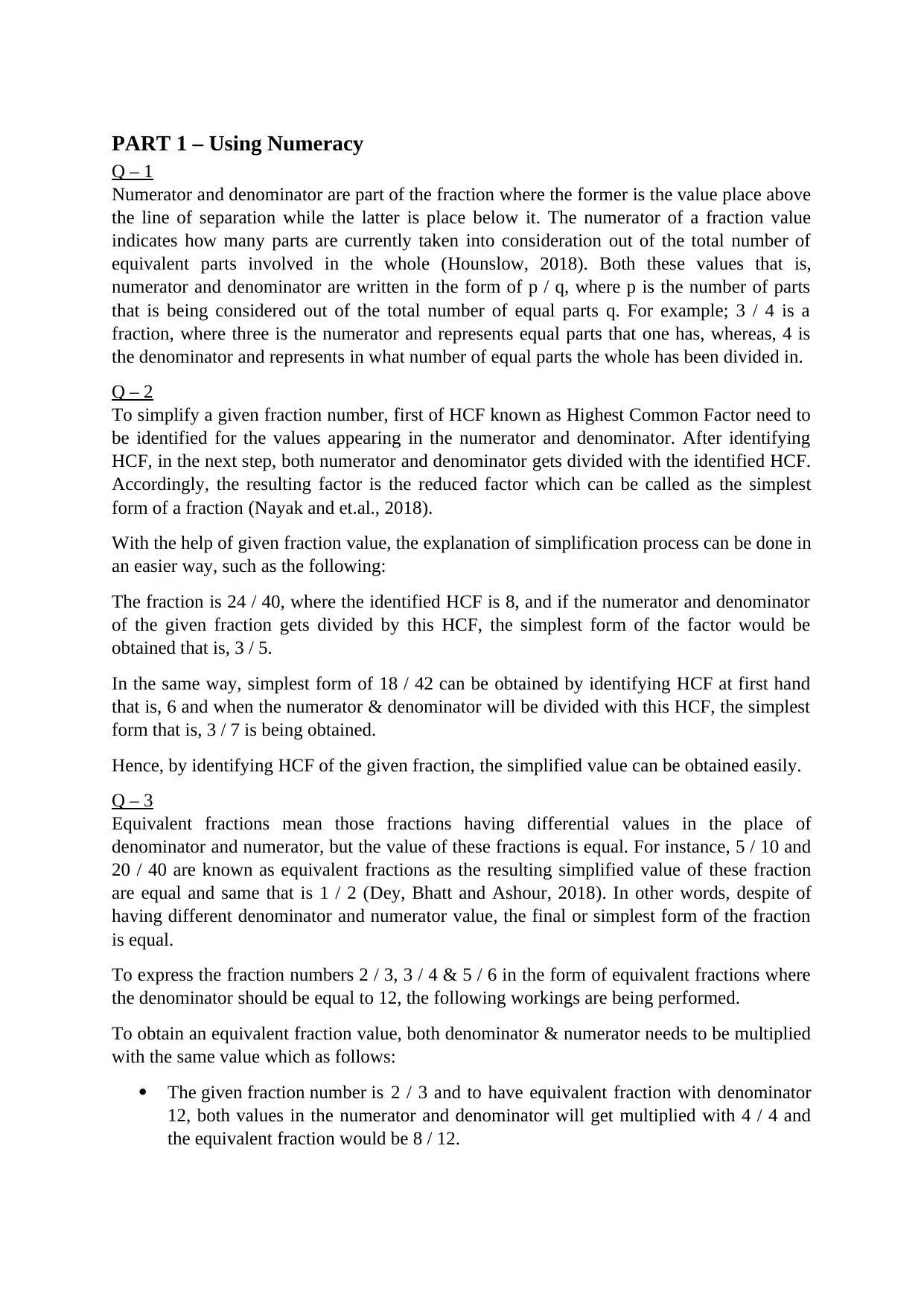
PART 1 – Using Numeracy
Q – 1
Numerator and denominator are part of the fraction where the former is the value place above
the line of separation while the latter is place below it. The numerator of a fraction value
indicates how many parts are currently taken into consideration out of the total number of
equivalent parts involved in the whole (Hounslow, 2018). Both these values that is,
numerator and denominator are written in the form of p / q, where p is the number of parts
that is being considered out of the total number of equal parts q. For example; 3 / 4 is a
fraction, where three is the numerator and represents equal parts that one has, whereas, 4 is
the denominator and represents in what number of equal parts the whole has been divided in.
Q – 2
To simplify a given fraction number, first of HCF known as Highest Common Factor need to
be identified for the values appearing in the numerator and denominator. After identifying
HCF, in the next step, both numerator and denominator gets divided with the identified HCF.
Accordingly, the resulting factor is the reduced factor which can be called as the simplest
form of a fraction (Nayak and et.al., 2018).
With the help of given fraction value, the explanation of simplification process can be done in
an easier way, such as the following:
The fraction is 24 / 40, where the identified HCF is 8, and if the numerator and denominator
of the given fraction gets divided by this HCF, the simplest form of the factor would be
obtained that is, 3 / 5.
In the same way, simplest form of 18 / 42 can be obtained by identifying HCF at first hand
that is, 6 and when the numerator & denominator will be divided with this HCF, the simplest
form that is, 3 / 7 is being obtained.
Hence, by identifying HCF of the given fraction, the simplified value can be obtained easily.
Q – 3
Equivalent fractions mean those fractions having differential values in the place of
denominator and numerator, but the value of these fractions is equal. For instance, 5 / 10 and
20 / 40 are known as equivalent fractions as the resulting simplified value of these fraction
are equal and same that is 1 / 2 (Dey, Bhatt and Ashour, 2018). In other words, despite of
having different denominator and numerator value, the final or simplest form of the fraction
is equal.
To express the fraction numbers 2 / 3, 3 / 4 & 5 / 6 in the form of equivalent fractions where
the denominator should be equal to 12, the following workings are being performed.
To obtain an equivalent fraction value, both denominator & numerator needs to be multiplied
with the same value which as follows:
The given fraction number is 2 / 3 and to have equivalent fraction with denominator
12, both values in the numerator and denominator will get multiplied with 4 / 4 and
the equivalent fraction would be 8 / 12.
Q – 1
Numerator and denominator are part of the fraction where the former is the value place above
the line of separation while the latter is place below it. The numerator of a fraction value
indicates how many parts are currently taken into consideration out of the total number of
equivalent parts involved in the whole (Hounslow, 2018). Both these values that is,
numerator and denominator are written in the form of p / q, where p is the number of parts
that is being considered out of the total number of equal parts q. For example; 3 / 4 is a
fraction, where three is the numerator and represents equal parts that one has, whereas, 4 is
the denominator and represents in what number of equal parts the whole has been divided in.
Q – 2
To simplify a given fraction number, first of HCF known as Highest Common Factor need to
be identified for the values appearing in the numerator and denominator. After identifying
HCF, in the next step, both numerator and denominator gets divided with the identified HCF.
Accordingly, the resulting factor is the reduced factor which can be called as the simplest
form of a fraction (Nayak and et.al., 2018).
With the help of given fraction value, the explanation of simplification process can be done in
an easier way, such as the following:
The fraction is 24 / 40, where the identified HCF is 8, and if the numerator and denominator
of the given fraction gets divided by this HCF, the simplest form of the factor would be
obtained that is, 3 / 5.
In the same way, simplest form of 18 / 42 can be obtained by identifying HCF at first hand
that is, 6 and when the numerator & denominator will be divided with this HCF, the simplest
form that is, 3 / 7 is being obtained.
Hence, by identifying HCF of the given fraction, the simplified value can be obtained easily.
Q – 3
Equivalent fractions mean those fractions having differential values in the place of
denominator and numerator, but the value of these fractions is equal. For instance, 5 / 10 and
20 / 40 are known as equivalent fractions as the resulting simplified value of these fraction
are equal and same that is 1 / 2 (Dey, Bhatt and Ashour, 2018). In other words, despite of
having different denominator and numerator value, the final or simplest form of the fraction
is equal.
To express the fraction numbers 2 / 3, 3 / 4 & 5 / 6 in the form of equivalent fractions where
the denominator should be equal to 12, the following workings are being performed.
To obtain an equivalent fraction value, both denominator & numerator needs to be multiplied
with the same value which as follows:
The given fraction number is 2 / 3 and to have equivalent fraction with denominator
12, both values in the numerator and denominator will get multiplied with 4 / 4 and
the equivalent fraction would be 8 / 12.
Secure Best Marks with AI Grader
Need help grading? Try our AI Grader for instant feedback on your assignments.
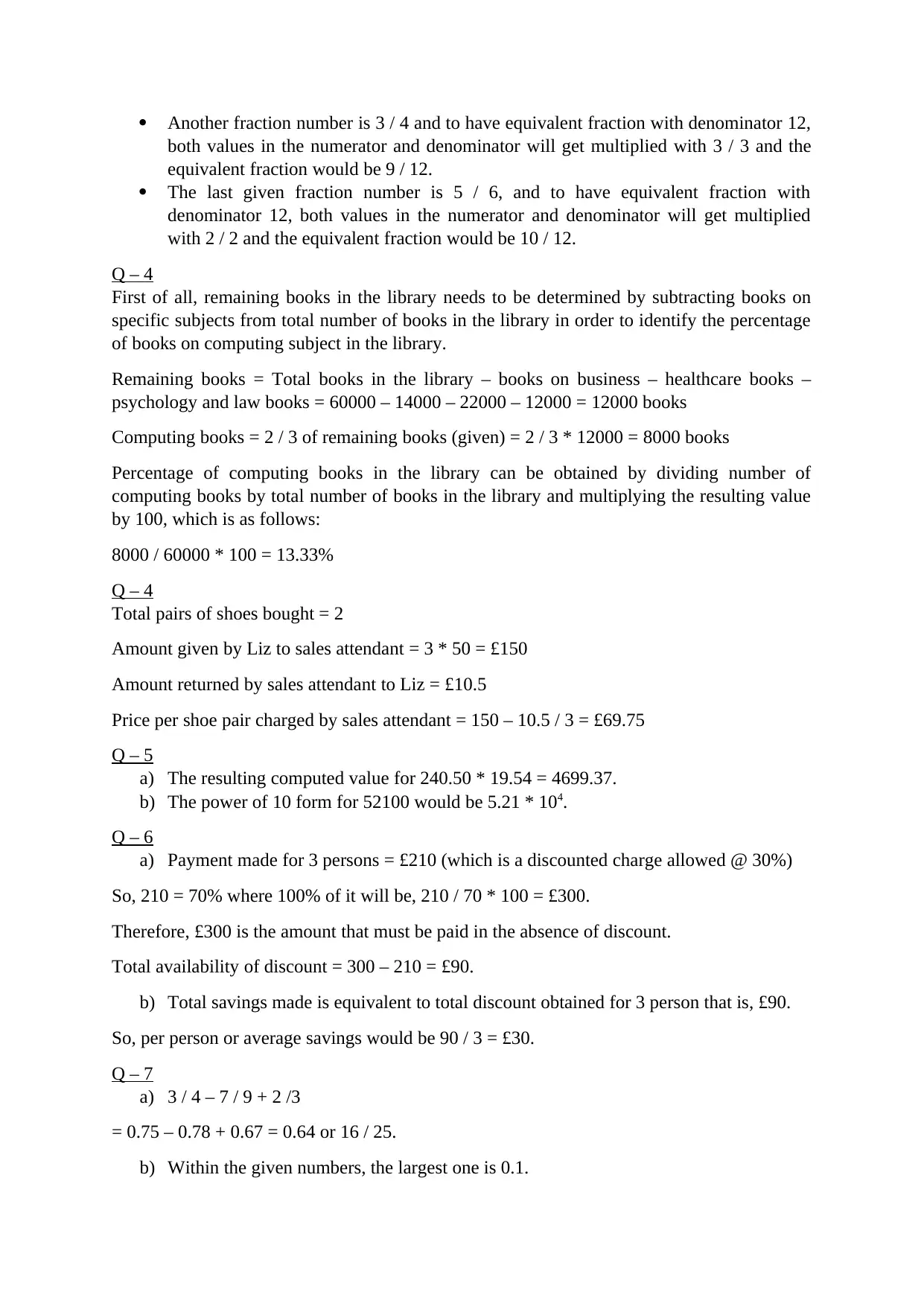
Another fraction number is 3 / 4 and to have equivalent fraction with denominator 12,
both values in the numerator and denominator will get multiplied with 3 / 3 and the
equivalent fraction would be 9 / 12.
The last given fraction number is 5 / 6, and to have equivalent fraction with
denominator 12, both values in the numerator and denominator will get multiplied
with 2 / 2 and the equivalent fraction would be 10 / 12.
Q – 4
First of all, remaining books in the library needs to be determined by subtracting books on
specific subjects from total number of books in the library in order to identify the percentage
of books on computing subject in the library.
Remaining books = Total books in the library – books on business – healthcare books –
psychology and law books = 60000 – 14000 – 22000 – 12000 = 12000 books
Computing books = 2 / 3 of remaining books (given) = 2 / 3 * 12000 = 8000 books
Percentage of computing books in the library can be obtained by dividing number of
computing books by total number of books in the library and multiplying the resulting value
by 100, which is as follows:
8000 / 60000 * 100 = 13.33%
Q – 4
Total pairs of shoes bought = 2
Amount given by Liz to sales attendant = 3 * 50 = £150
Amount returned by sales attendant to Liz = £10.5
Price per shoe pair charged by sales attendant = 150 – 10.5 / 3 = £69.75
Q – 5
a) The resulting computed value for 240.50 * 19.54 = 4699.37.
b) The power of 10 form for 52100 would be 5.21 * 104.
Q – 6
a) Payment made for 3 persons = £210 (which is a discounted charge allowed @ 30%)
So, 210 = 70% where 100% of it will be, 210 / 70 * 100 = £300.
Therefore, £300 is the amount that must be paid in the absence of discount.
Total availability of discount = 300 – 210 = £90.
b) Total savings made is equivalent to total discount obtained for 3 person that is, £90.
So, per person or average savings would be 90 / 3 = £30.
Q – 7
a) 3 / 4 – 7 / 9 + 2 /3
= 0.75 – 0.78 + 0.67 = 0.64 or 16 / 25.
b) Within the given numbers, the largest one is 0.1.
both values in the numerator and denominator will get multiplied with 3 / 3 and the
equivalent fraction would be 9 / 12.
The last given fraction number is 5 / 6, and to have equivalent fraction with
denominator 12, both values in the numerator and denominator will get multiplied
with 2 / 2 and the equivalent fraction would be 10 / 12.
Q – 4
First of all, remaining books in the library needs to be determined by subtracting books on
specific subjects from total number of books in the library in order to identify the percentage
of books on computing subject in the library.
Remaining books = Total books in the library – books on business – healthcare books –
psychology and law books = 60000 – 14000 – 22000 – 12000 = 12000 books
Computing books = 2 / 3 of remaining books (given) = 2 / 3 * 12000 = 8000 books
Percentage of computing books in the library can be obtained by dividing number of
computing books by total number of books in the library and multiplying the resulting value
by 100, which is as follows:
8000 / 60000 * 100 = 13.33%
Q – 4
Total pairs of shoes bought = 2
Amount given by Liz to sales attendant = 3 * 50 = £150
Amount returned by sales attendant to Liz = £10.5
Price per shoe pair charged by sales attendant = 150 – 10.5 / 3 = £69.75
Q – 5
a) The resulting computed value for 240.50 * 19.54 = 4699.37.
b) The power of 10 form for 52100 would be 5.21 * 104.
Q – 6
a) Payment made for 3 persons = £210 (which is a discounted charge allowed @ 30%)
So, 210 = 70% where 100% of it will be, 210 / 70 * 100 = £300.
Therefore, £300 is the amount that must be paid in the absence of discount.
Total availability of discount = 300 – 210 = £90.
b) Total savings made is equivalent to total discount obtained for 3 person that is, £90.
So, per person or average savings would be 90 / 3 = £30.
Q – 7
a) 3 / 4 – 7 / 9 + 2 /3
= 0.75 – 0.78 + 0.67 = 0.64 or 16 / 25.
b) Within the given numbers, the largest one is 0.1.
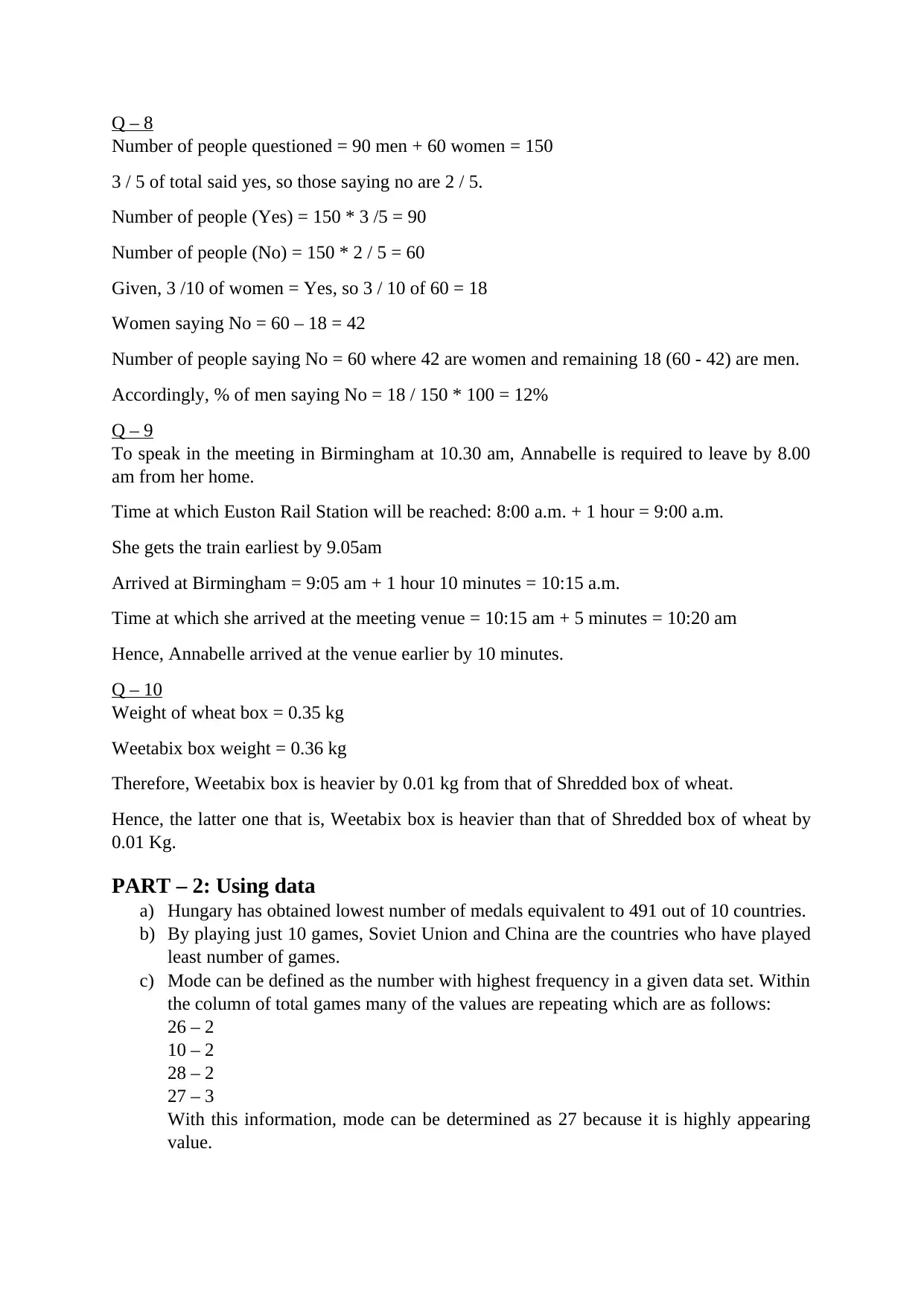
Q – 8
Number of people questioned = 90 men + 60 women = 150
3 / 5 of total said yes, so those saying no are 2 / 5.
Number of people (Yes) = 150 * 3 /5 = 90
Number of people (No) = 150 * 2 / 5 = 60
Given, 3 /10 of women = Yes, so 3 / 10 of 60 = 18
Women saying No = 60 – 18 = 42
Number of people saying No = 60 where 42 are women and remaining 18 (60 - 42) are men.
Accordingly, % of men saying No = 18 / 150 * 100 = 12%
Q – 9
To speak in the meeting in Birmingham at 10.30 am, Annabelle is required to leave by 8.00
am from her home.
Time at which Euston Rail Station will be reached: 8:00 a.m. + 1 hour = 9:00 a.m.
She gets the train earliest by 9.05am
Arrived at Birmingham = 9:05 am + 1 hour 10 minutes = 10:15 a.m.
Time at which she arrived at the meeting venue = 10:15 am + 5 minutes = 10:20 am
Hence, Annabelle arrived at the venue earlier by 10 minutes.
Q – 10
Weight of wheat box = 0.35 kg
Weetabix box weight = 0.36 kg
Therefore, Weetabix box is heavier by 0.01 kg from that of Shredded box of wheat.
Hence, the latter one that is, Weetabix box is heavier than that of Shredded box of wheat by
0.01 Kg.
PART – 2: Using data
a) Hungary has obtained lowest number of medals equivalent to 491 out of 10 countries.
b) By playing just 10 games, Soviet Union and China are the countries who have played
least number of games.
c) Mode can be defined as the number with highest frequency in a given data set. Within
the column of total games many of the values are repeating which are as follows:
26 – 2
10 – 2
28 – 2
27 – 3
With this information, mode can be determined as 27 because it is highly appearing
value.
Number of people questioned = 90 men + 60 women = 150
3 / 5 of total said yes, so those saying no are 2 / 5.
Number of people (Yes) = 150 * 3 /5 = 90
Number of people (No) = 150 * 2 / 5 = 60
Given, 3 /10 of women = Yes, so 3 / 10 of 60 = 18
Women saying No = 60 – 18 = 42
Number of people saying No = 60 where 42 are women and remaining 18 (60 - 42) are men.
Accordingly, % of men saying No = 18 / 150 * 100 = 12%
Q – 9
To speak in the meeting in Birmingham at 10.30 am, Annabelle is required to leave by 8.00
am from her home.
Time at which Euston Rail Station will be reached: 8:00 a.m. + 1 hour = 9:00 a.m.
She gets the train earliest by 9.05am
Arrived at Birmingham = 9:05 am + 1 hour 10 minutes = 10:15 a.m.
Time at which she arrived at the meeting venue = 10:15 am + 5 minutes = 10:20 am
Hence, Annabelle arrived at the venue earlier by 10 minutes.
Q – 10
Weight of wheat box = 0.35 kg
Weetabix box weight = 0.36 kg
Therefore, Weetabix box is heavier by 0.01 kg from that of Shredded box of wheat.
Hence, the latter one that is, Weetabix box is heavier than that of Shredded box of wheat by
0.01 Kg.
PART – 2: Using data
a) Hungary has obtained lowest number of medals equivalent to 491 out of 10 countries.
b) By playing just 10 games, Soviet Union and China are the countries who have played
least number of games.
c) Mode can be defined as the number with highest frequency in a given data set. Within
the column of total games many of the values are repeating which are as follows:
26 – 2
10 – 2
28 – 2
27 – 3
With this information, mode can be determined as 27 because it is highly appearing
value.
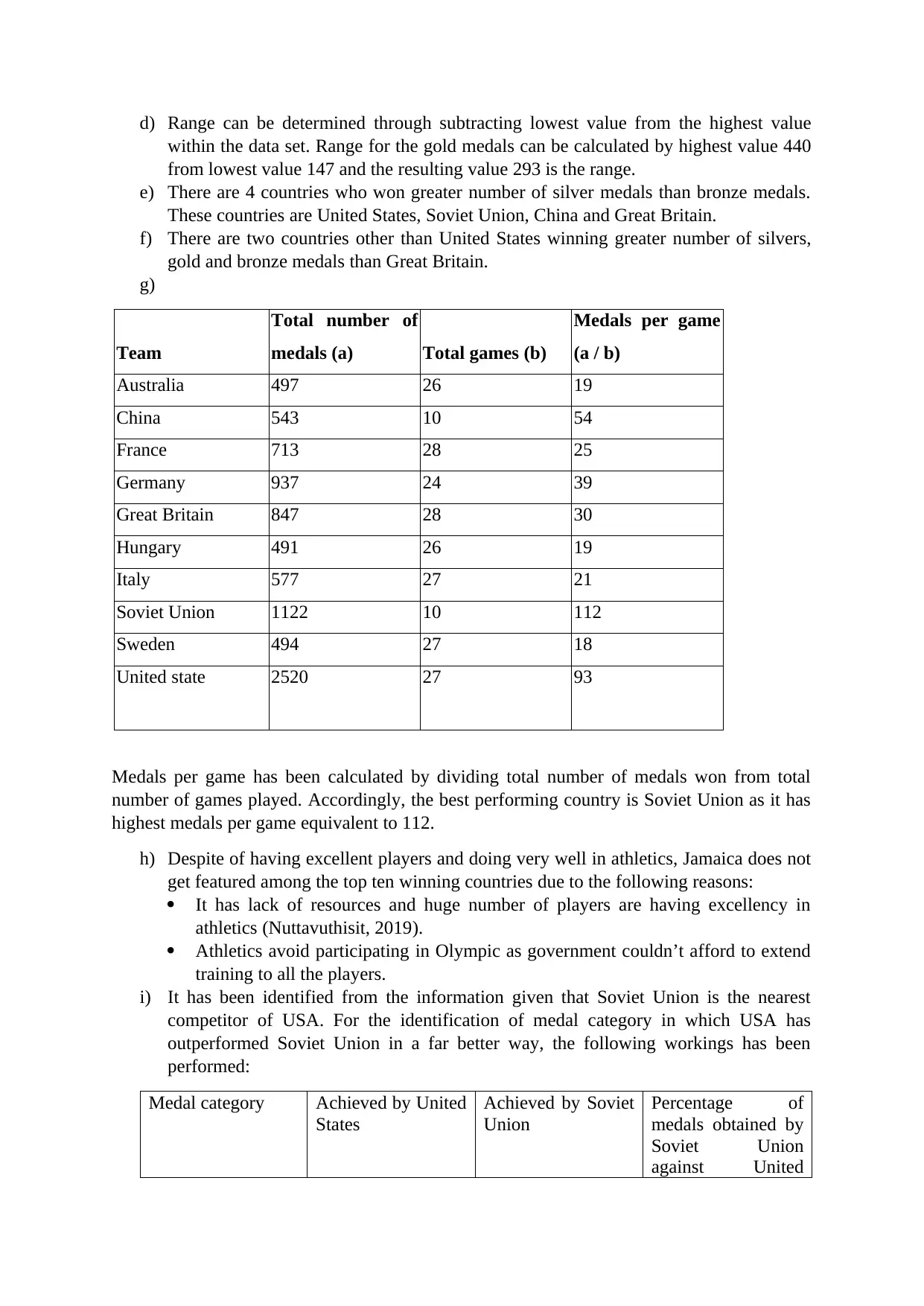
d) Range can be determined through subtracting lowest value from the highest value
within the data set. Range for the gold medals can be calculated by highest value 440
from lowest value 147 and the resulting value 293 is the range.
e) There are 4 countries who won greater number of silver medals than bronze medals.
These countries are United States, Soviet Union, China and Great Britain.
f) There are two countries other than United States winning greater number of silvers,
gold and bronze medals than Great Britain.
g)
Team
Total number of
medals (a) Total games (b)
Medals per game
(a / b)
Australia 497 26 19
China 543 10 54
France 713 28 25
Germany 937 24 39
Great Britain 847 28 30
Hungary 491 26 19
Italy 577 27 21
Soviet Union 1122 10 112
Sweden 494 27 18
United state 2520 27 93
Medals per game has been calculated by dividing total number of medals won from total
number of games played. Accordingly, the best performing country is Soviet Union as it has
highest medals per game equivalent to 112.
h) Despite of having excellent players and doing very well in athletics, Jamaica does not
get featured among the top ten winning countries due to the following reasons:
It has lack of resources and huge number of players are having excellency in
athletics (Nuttavuthisit, 2019).
Athletics avoid participating in Olympic as government couldn’t afford to extend
training to all the players.
i) It has been identified from the information given that Soviet Union is the nearest
competitor of USA. For the identification of medal category in which USA has
outperformed Soviet Union in a far better way, the following workings has been
performed:
Medal category Achieved by United
States
Achieved by Soviet
Union
Percentage of
medals obtained by
Soviet Union
against United
within the data set. Range for the gold medals can be calculated by highest value 440
from lowest value 147 and the resulting value 293 is the range.
e) There are 4 countries who won greater number of silver medals than bronze medals.
These countries are United States, Soviet Union, China and Great Britain.
f) There are two countries other than United States winning greater number of silvers,
gold and bronze medals than Great Britain.
g)
Team
Total number of
medals (a) Total games (b)
Medals per game
(a / b)
Australia 497 26 19
China 543 10 54
France 713 28 25
Germany 937 24 39
Great Britain 847 28 30
Hungary 491 26 19
Italy 577 27 21
Soviet Union 1122 10 112
Sweden 494 27 18
United state 2520 27 93
Medals per game has been calculated by dividing total number of medals won from total
number of games played. Accordingly, the best performing country is Soviet Union as it has
highest medals per game equivalent to 112.
h) Despite of having excellent players and doing very well in athletics, Jamaica does not
get featured among the top ten winning countries due to the following reasons:
It has lack of resources and huge number of players are having excellency in
athletics (Nuttavuthisit, 2019).
Athletics avoid participating in Olympic as government couldn’t afford to extend
training to all the players.
i) It has been identified from the information given that Soviet Union is the nearest
competitor of USA. For the identification of medal category in which USA has
outperformed Soviet Union in a far better way, the following workings has been
performed:
Medal category Achieved by United
States
Achieved by Soviet
Union
Percentage of
medals obtained by
Soviet Union
against United
Paraphrase This Document
Need a fresh take? Get an instant paraphrase of this document with our AI Paraphraser
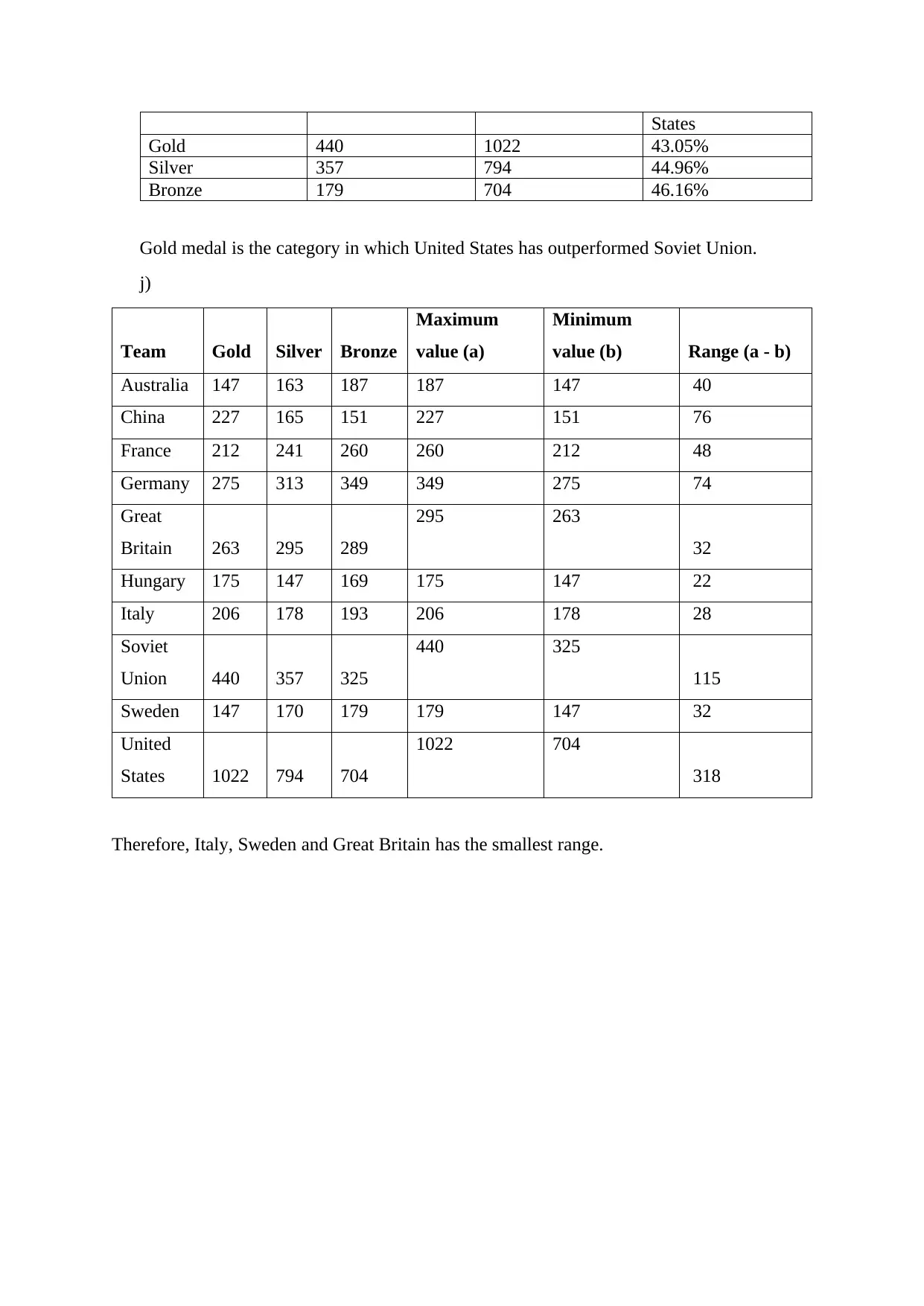
States
Gold 440 1022 43.05%
Silver 357 794 44.96%
Bronze 179 704 46.16%
Gold medal is the category in which United States has outperformed Soviet Union.
j)
Team Gold Silver Bronze
Maximum
value (a)
Minimum
value (b) Range (a - b)
Australia 147 163 187 187 147 40
China 227 165 151 227 151 76
France 212 241 260 260 212 48
Germany 275 313 349 349 275 74
Great
Britain 263 295 289
295 263
32
Hungary 175 147 169 175 147 22
Italy 206 178 193 206 178 28
Soviet
Union 440 357 325
440 325
115
Sweden 147 170 179 179 147 32
United
States 1022 794 704
1022 704
318
Therefore, Italy, Sweden and Great Britain has the smallest range.
Gold 440 1022 43.05%
Silver 357 794 44.96%
Bronze 179 704 46.16%
Gold medal is the category in which United States has outperformed Soviet Union.
j)
Team Gold Silver Bronze
Maximum
value (a)
Minimum
value (b) Range (a - b)
Australia 147 163 187 187 147 40
China 227 165 151 227 151 76
France 212 241 260 260 212 48
Germany 275 313 349 349 275 74
Great
Britain 263 295 289
295 263
32
Hungary 175 147 169 175 147 22
Italy 206 178 193 206 178 28
Soviet
Union 440 357 325
440 325
115
Sweden 147 170 179 179 147 32
United
States 1022 794 704
1022 704
318
Therefore, Italy, Sweden and Great Britain has the smallest range.
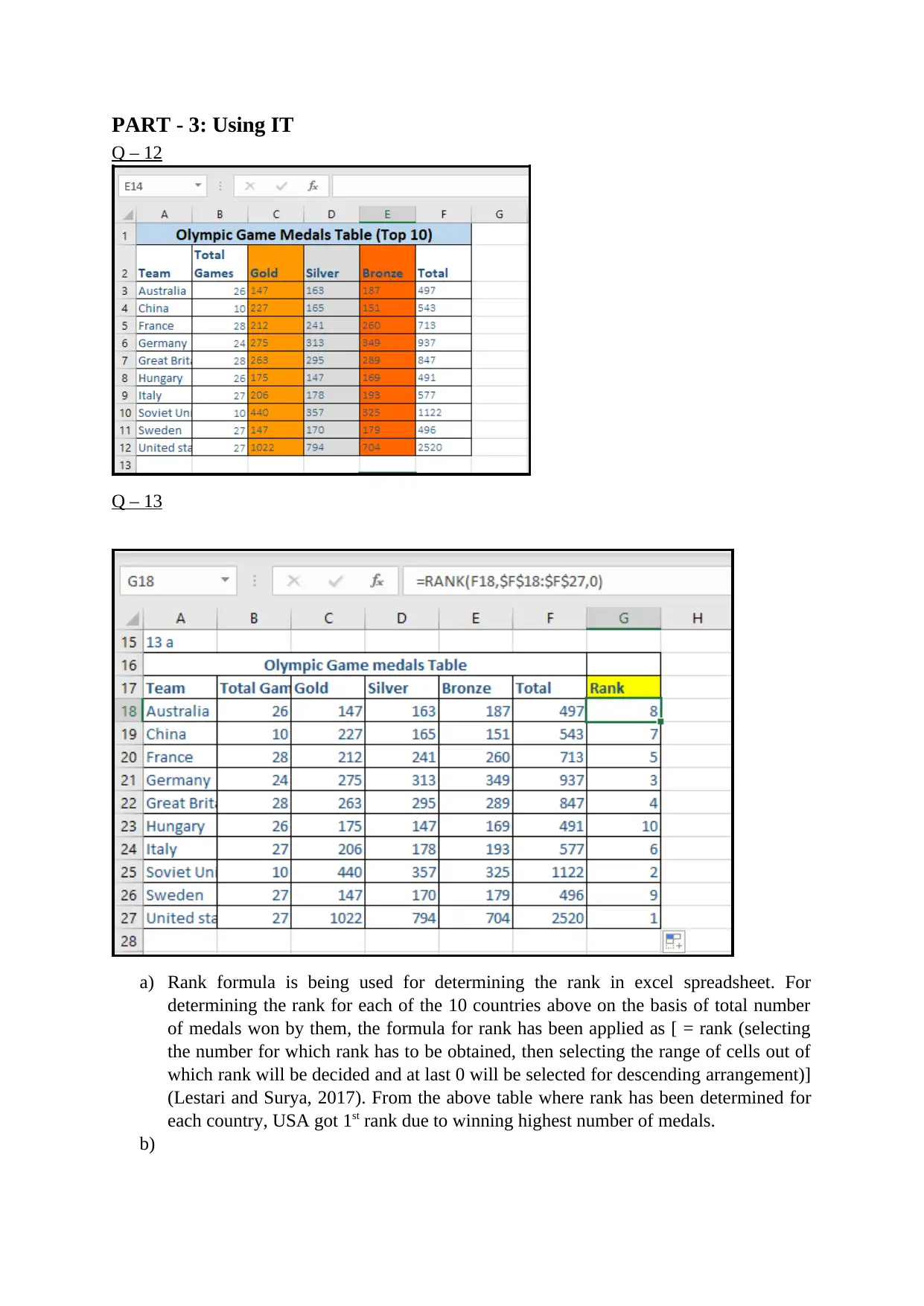
PART - 3: Using IT
Q – 12
Q – 13
a) Rank formula is being used for determining the rank in excel spreadsheet. For
determining the rank for each of the 10 countries above on the basis of total number
of medals won by them, the formula for rank has been applied as [ = rank (selecting
the number for which rank has to be obtained, then selecting the range of cells out of
which rank will be decided and at last 0 will be selected for descending arrangement)]
(Lestari and Surya, 2017). From the above table where rank has been determined for
each country, USA got 1st rank due to winning highest number of medals.
b)
Q – 12
Q – 13
a) Rank formula is being used for determining the rank in excel spreadsheet. For
determining the rank for each of the 10 countries above on the basis of total number
of medals won by them, the formula for rank has been applied as [ = rank (selecting
the number for which rank has to be obtained, then selecting the range of cells out of
which rank will be decided and at last 0 will be selected for descending arrangement)]
(Lestari and Surya, 2017). From the above table where rank has been determined for
each country, USA got 1st rank due to winning highest number of medals.
b)
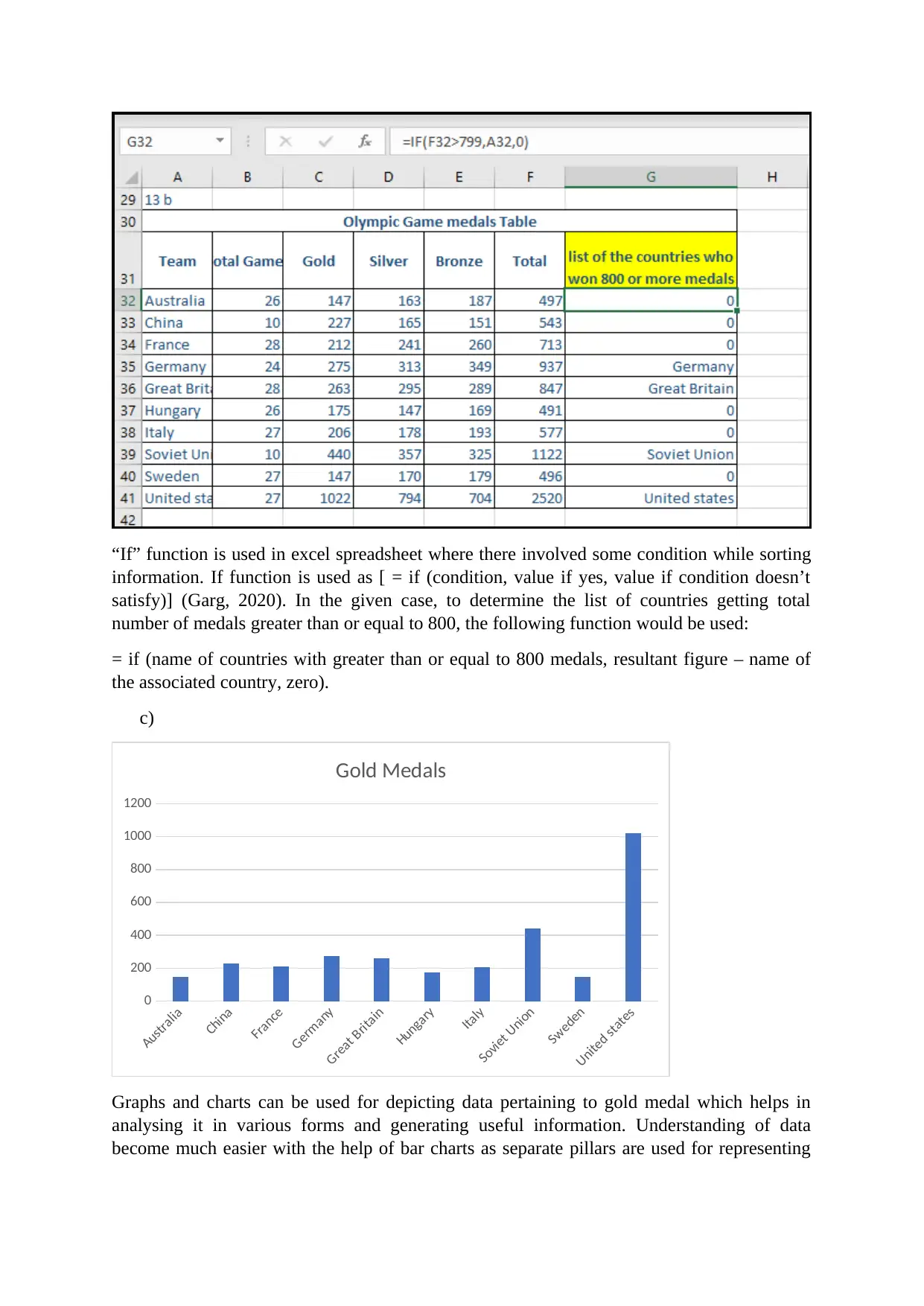
“If” function is used in excel spreadsheet where there involved some condition while sorting
information. If function is used as [ = if (condition, value if yes, value if condition doesn’t
satisfy)] (Garg, 2020). In the given case, to determine the list of countries getting total
number of medals greater than or equal to 800, the following function would be used:
= if (name of countries with greater than or equal to 800 medals, resultant figure – name of
the associated country, zero).
c)
Australia
China
France
Germany
Great Britain
Hungary
Italy
Soviet Union
Sweden
United states
0
200
400
600
800
1000
1200
Gold Medals
Graphs and charts can be used for depicting data pertaining to gold medal which helps in
analysing it in various forms and generating useful information. Understanding of data
become much easier with the help of bar charts as separate pillars are used for representing
information. If function is used as [ = if (condition, value if yes, value if condition doesn’t
satisfy)] (Garg, 2020). In the given case, to determine the list of countries getting total
number of medals greater than or equal to 800, the following function would be used:
= if (name of countries with greater than or equal to 800 medals, resultant figure – name of
the associated country, zero).
c)
Australia
China
France
Germany
Great Britain
Hungary
Italy
Soviet Union
Sweden
United states
0
200
400
600
800
1000
1200
Gold Medals
Graphs and charts can be used for depicting data pertaining to gold medal which helps in
analysing it in various forms and generating useful information. Understanding of data
become much easier with the help of bar charts as separate pillars are used for representing
Secure Best Marks with AI Grader
Need help grading? Try our AI Grader for instant feedback on your assignments.
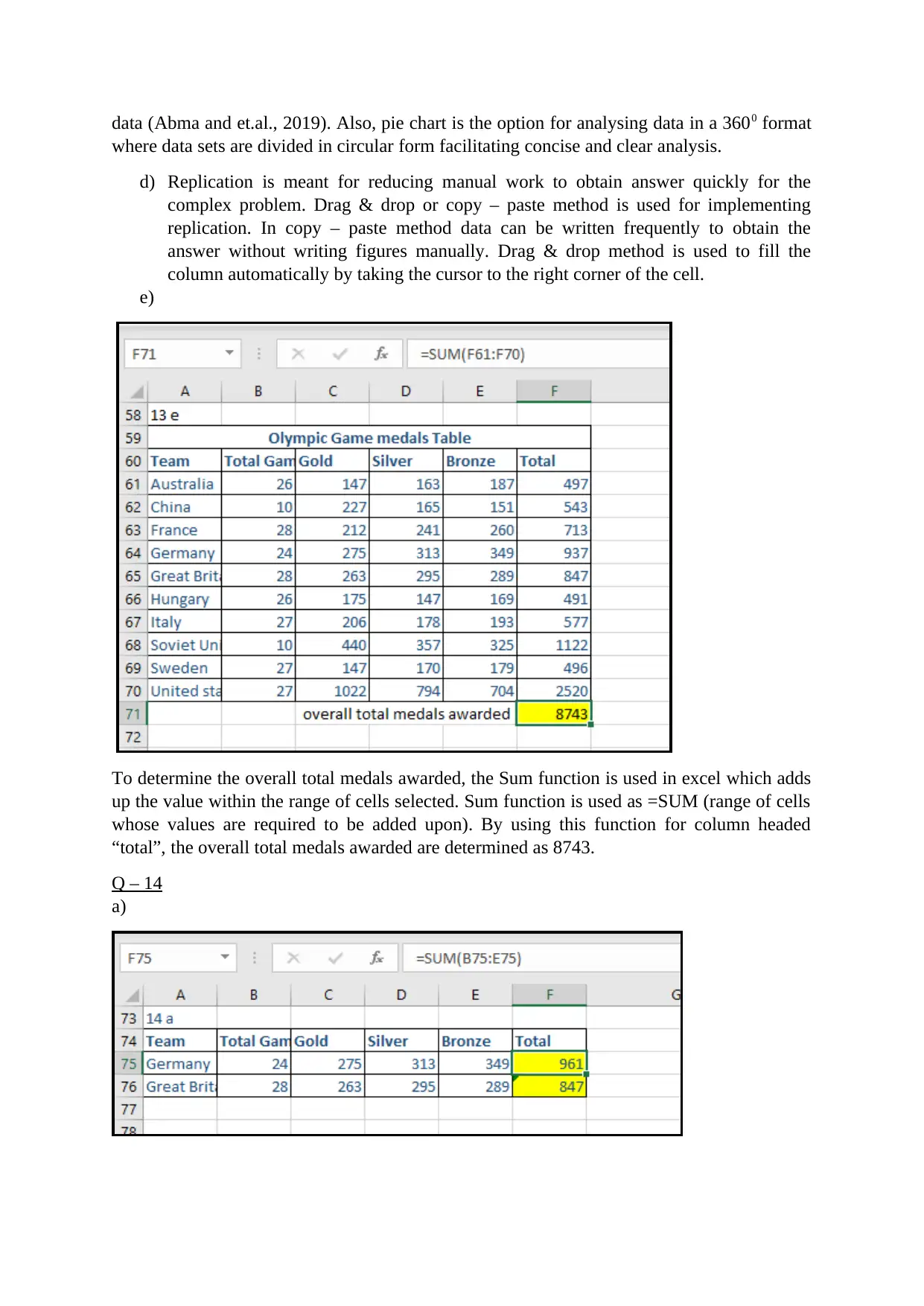
data (Abma and et.al., 2019). Also, pie chart is the option for analysing data in a 3600 format
where data sets are divided in circular form facilitating concise and clear analysis.
d) Replication is meant for reducing manual work to obtain answer quickly for the
complex problem. Drag & drop or copy – paste method is used for implementing
replication. In copy – paste method data can be written frequently to obtain the
answer without writing figures manually. Drag & drop method is used to fill the
column automatically by taking the cursor to the right corner of the cell.
e)
To determine the overall total medals awarded, the Sum function is used in excel which adds
up the value within the range of cells selected. Sum function is used as =SUM (range of cells
whose values are required to be added upon). By using this function for column headed
“total”, the overall total medals awarded are determined as 8743.
Q – 14
a)
where data sets are divided in circular form facilitating concise and clear analysis.
d) Replication is meant for reducing manual work to obtain answer quickly for the
complex problem. Drag & drop or copy – paste method is used for implementing
replication. In copy – paste method data can be written frequently to obtain the
answer without writing figures manually. Drag & drop method is used to fill the
column automatically by taking the cursor to the right corner of the cell.
e)
To determine the overall total medals awarded, the Sum function is used in excel which adds
up the value within the range of cells selected. Sum function is used as =SUM (range of cells
whose values are required to be added upon). By using this function for column headed
“total”, the overall total medals awarded are determined as 8743.
Q – 14
a)
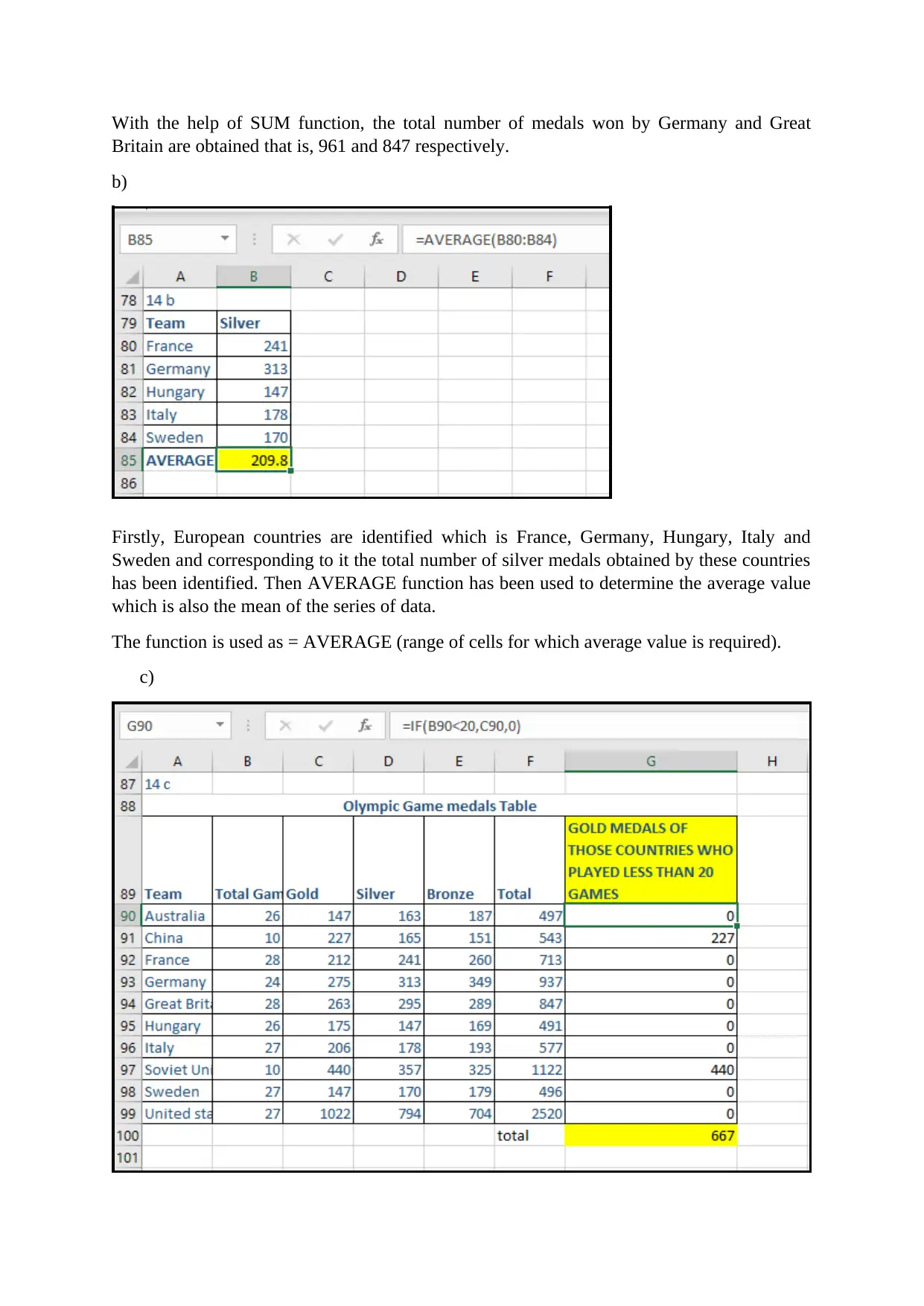
With the help of SUM function, the total number of medals won by Germany and Great
Britain are obtained that is, 961 and 847 respectively.
b)
Firstly, European countries are identified which is France, Germany, Hungary, Italy and
Sweden and corresponding to it the total number of silver medals obtained by these countries
has been identified. Then AVERAGE function has been used to determine the average value
which is also the mean of the series of data.
The function is used as = AVERAGE (range of cells for which average value is required).
c)
Britain are obtained that is, 961 and 847 respectively.
b)
Firstly, European countries are identified which is France, Germany, Hungary, Italy and
Sweden and corresponding to it the total number of silver medals obtained by these countries
has been identified. Then AVERAGE function has been used to determine the average value
which is also the mean of the series of data.
The function is used as = AVERAGE (range of cells for which average value is required).
c)
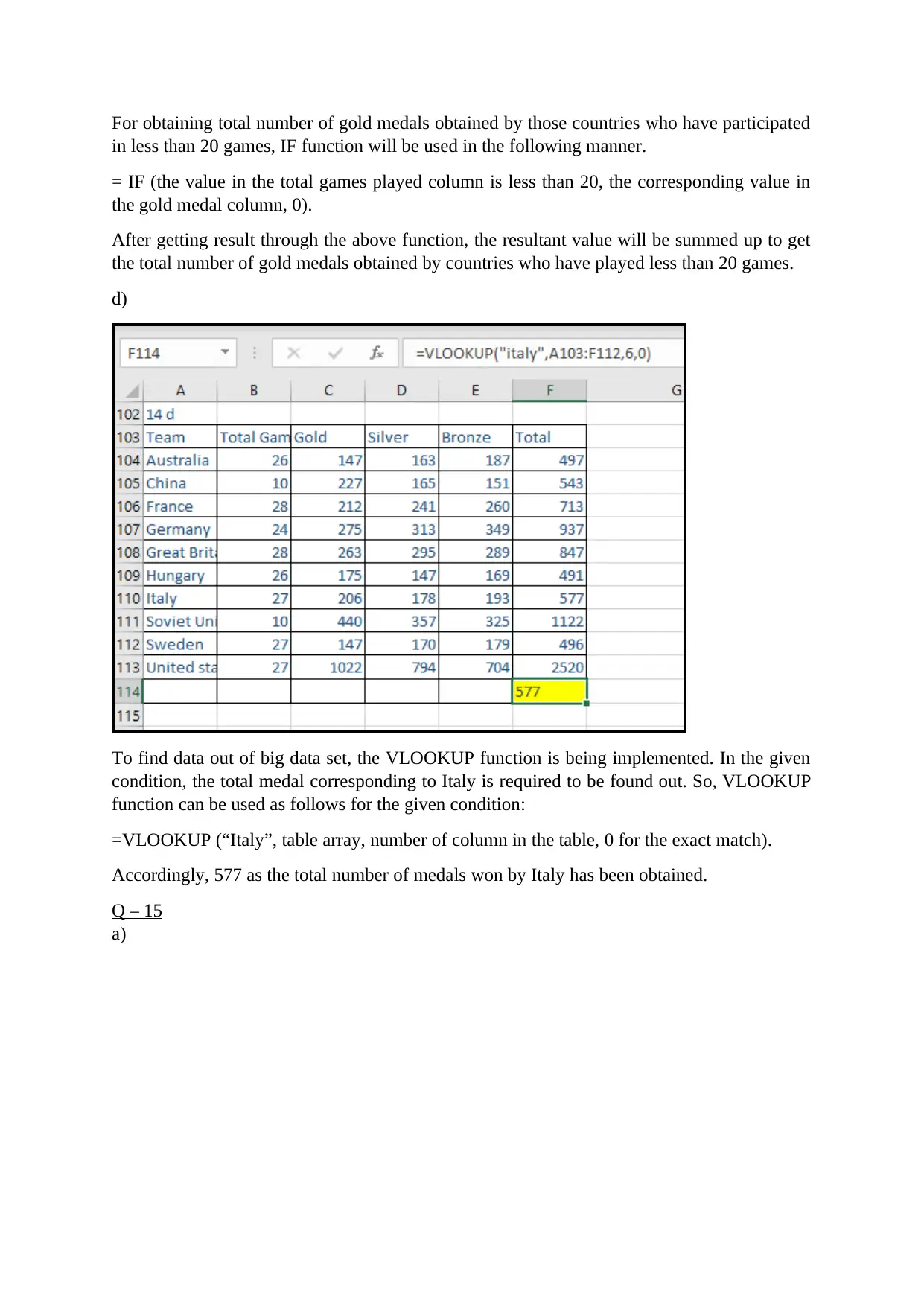
For obtaining total number of gold medals obtained by those countries who have participated
in less than 20 games, IF function will be used in the following manner.
= IF (the value in the total games played column is less than 20, the corresponding value in
the gold medal column, 0).
After getting result through the above function, the resultant value will be summed up to get
the total number of gold medals obtained by countries who have played less than 20 games.
d)
To find data out of big data set, the VLOOKUP function is being implemented. In the given
condition, the total medal corresponding to Italy is required to be found out. So, VLOOKUP
function can be used as follows for the given condition:
=VLOOKUP (“Italy”, table array, number of column in the table, 0 for the exact match).
Accordingly, 577 as the total number of medals won by Italy has been obtained.
Q – 15
a)
in less than 20 games, IF function will be used in the following manner.
= IF (the value in the total games played column is less than 20, the corresponding value in
the gold medal column, 0).
After getting result through the above function, the resultant value will be summed up to get
the total number of gold medals obtained by countries who have played less than 20 games.
d)
To find data out of big data set, the VLOOKUP function is being implemented. In the given
condition, the total medal corresponding to Italy is required to be found out. So, VLOOKUP
function can be used as follows for the given condition:
=VLOOKUP (“Italy”, table array, number of column in the table, 0 for the exact match).
Accordingly, 577 as the total number of medals won by Italy has been obtained.
Q – 15
a)
Paraphrase This Document
Need a fresh take? Get an instant paraphrase of this document with our AI Paraphraser
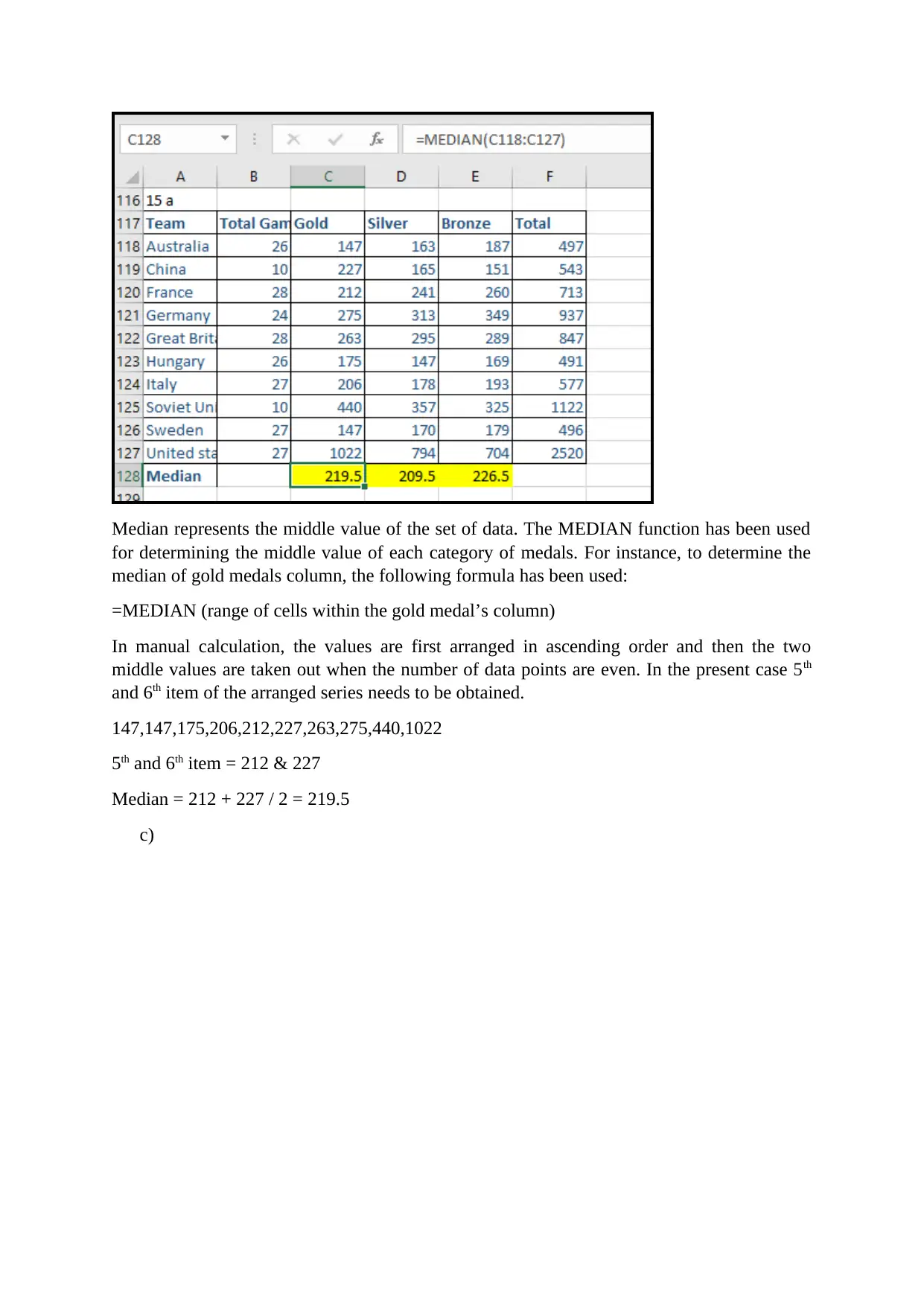
Median represents the middle value of the set of data. The MEDIAN function has been used
for determining the middle value of each category of medals. For instance, to determine the
median of gold medals column, the following formula has been used:
=MEDIAN (range of cells within the gold medal’s column)
In manual calculation, the values are first arranged in ascending order and then the two
middle values are taken out when the number of data points are even. In the present case 5th
and 6th item of the arranged series needs to be obtained.
147,147,175,206,212,227,263,275,440,1022
5th and 6th item = 212 & 227
Median = 212 + 227 / 2 = 219.5
c)
for determining the middle value of each category of medals. For instance, to determine the
median of gold medals column, the following formula has been used:
=MEDIAN (range of cells within the gold medal’s column)
In manual calculation, the values are first arranged in ascending order and then the two
middle values are taken out when the number of data points are even. In the present case 5th
and 6th item of the arranged series needs to be obtained.
147,147,175,206,212,227,263,275,440,1022
5th and 6th item = 212 & 227
Median = 212 + 227 / 2 = 219.5
c)
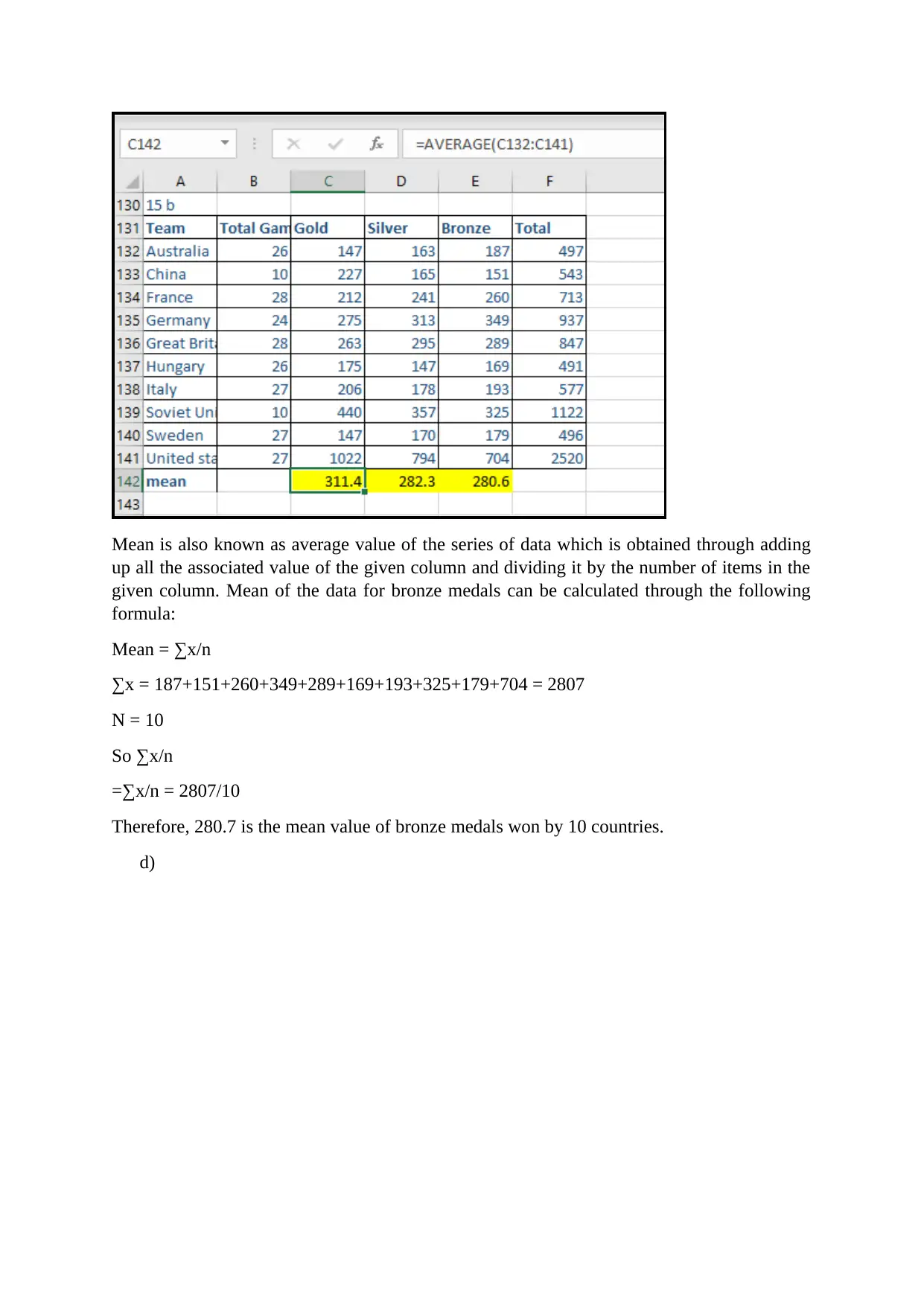
Mean is also known as average value of the series of data which is obtained through adding
up all the associated value of the given column and dividing it by the number of items in the
given column. Mean of the data for bronze medals can be calculated through the following
formula:
Mean = ∑x/n
∑x = 187+151+260+349+289+169+193+325+179+704 = 2807
N = 10
So ∑x/n
=∑x/n = 2807/10
Therefore, 280.7 is the mean value of bronze medals won by 10 countries.
d)
up all the associated value of the given column and dividing it by the number of items in the
given column. Mean of the data for bronze medals can be calculated through the following
formula:
Mean = ∑x/n
∑x = 187+151+260+349+289+169+193+325+179+704 = 2807
N = 10
So ∑x/n
=∑x/n = 2807/10
Therefore, 280.7 is the mean value of bronze medals won by 10 countries.
d)

Secure Best Marks with AI Grader
Need help grading? Try our AI Grader for instant feedback on your assignments.
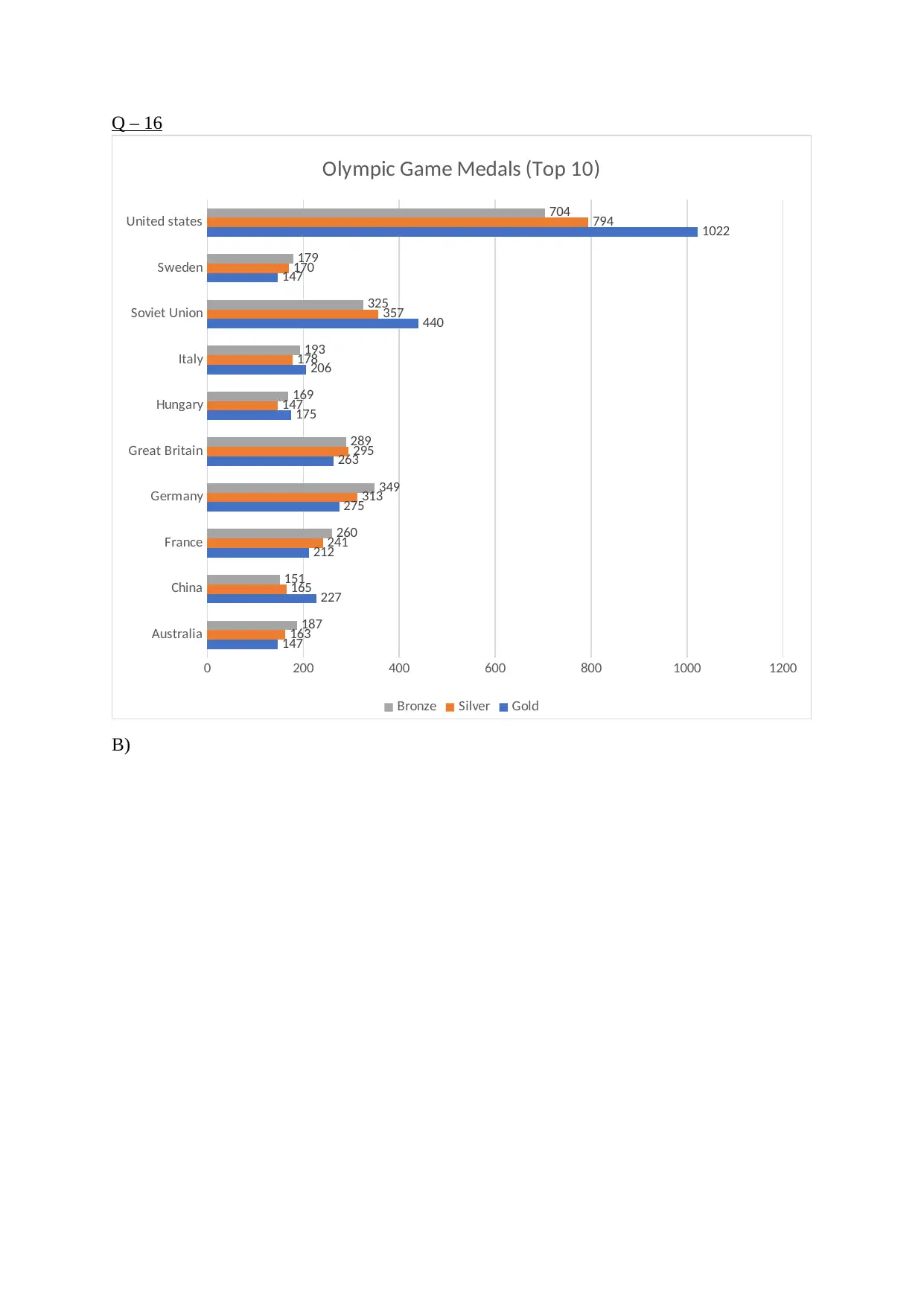
Q – 16
Australia
China
France
Germany
Great Britain
Hungary
Italy
Soviet Union
Sweden
United states
0 200 400 600 800 1000 1200
147
227
212
275
263
175
206
440
147
1022
163
165
241
313
295
147
178
357
170
794
187
151
260
349
289
169
193
325
179
704
Olympic Game Medals (Top 10)
Bronze Silver Gold
B)
Australia
China
France
Germany
Great Britain
Hungary
Italy
Soviet Union
Sweden
United states
0 200 400 600 800 1000 1200
147
227
212
275
263
175
206
440
147
1022
163
165
241
313
295
147
178
357
170
794
187
151
260
349
289
169
193
325
179
704
Olympic Game Medals (Top 10)
Bronze Silver Gold
B)
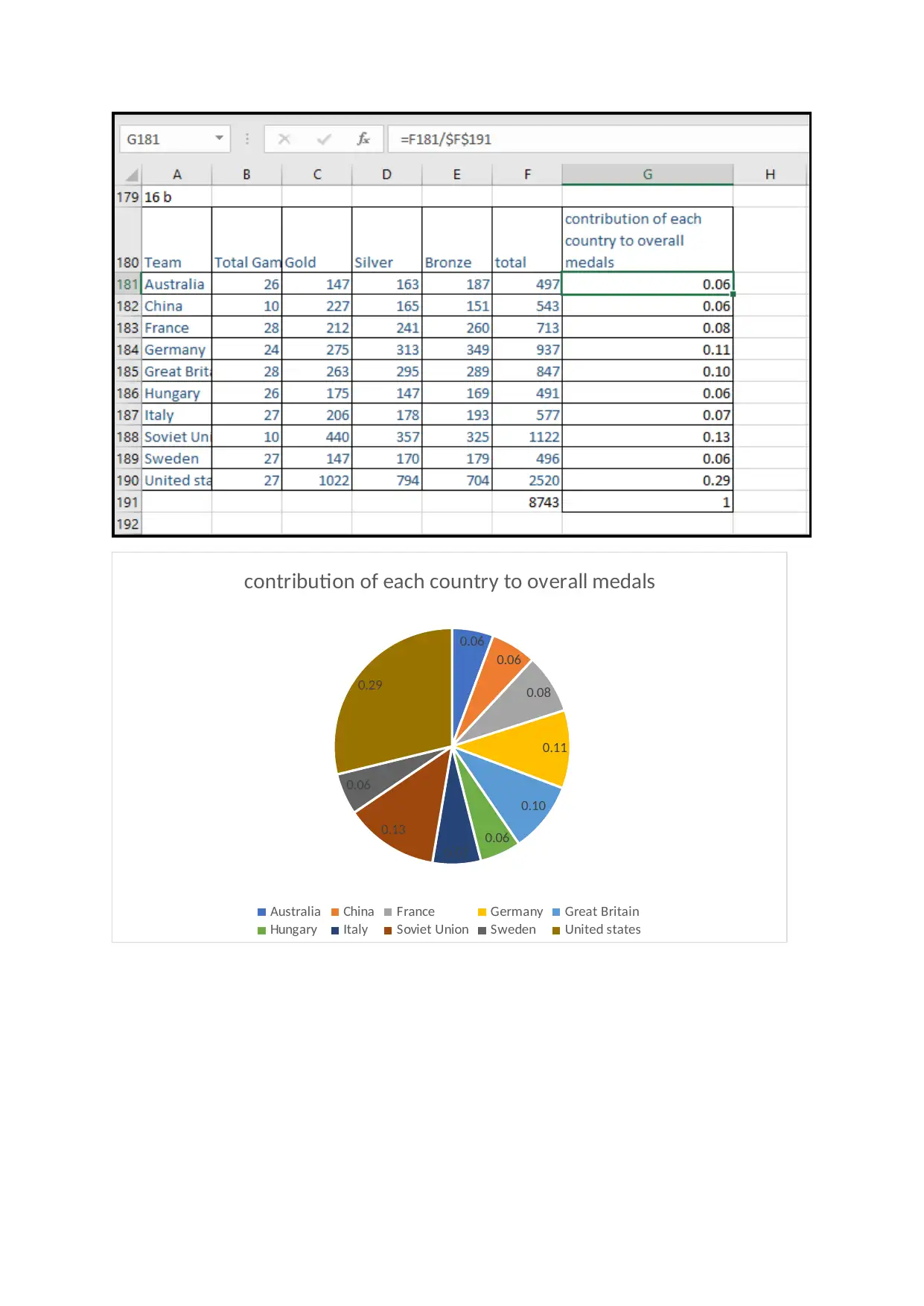
0.06
0.06
0.08
0.11
0.10
0.06
0.07
0.13
0.06
0.29
contribution of each country to overall medals
Australia China France Germany Great Britain
Hungary Italy Soviet Union Sweden United states
0.06
0.08
0.11
0.10
0.06
0.07
0.13
0.06
0.29
contribution of each country to overall medals
Australia China France Germany Great Britain
Hungary Italy Soviet Union Sweden United states
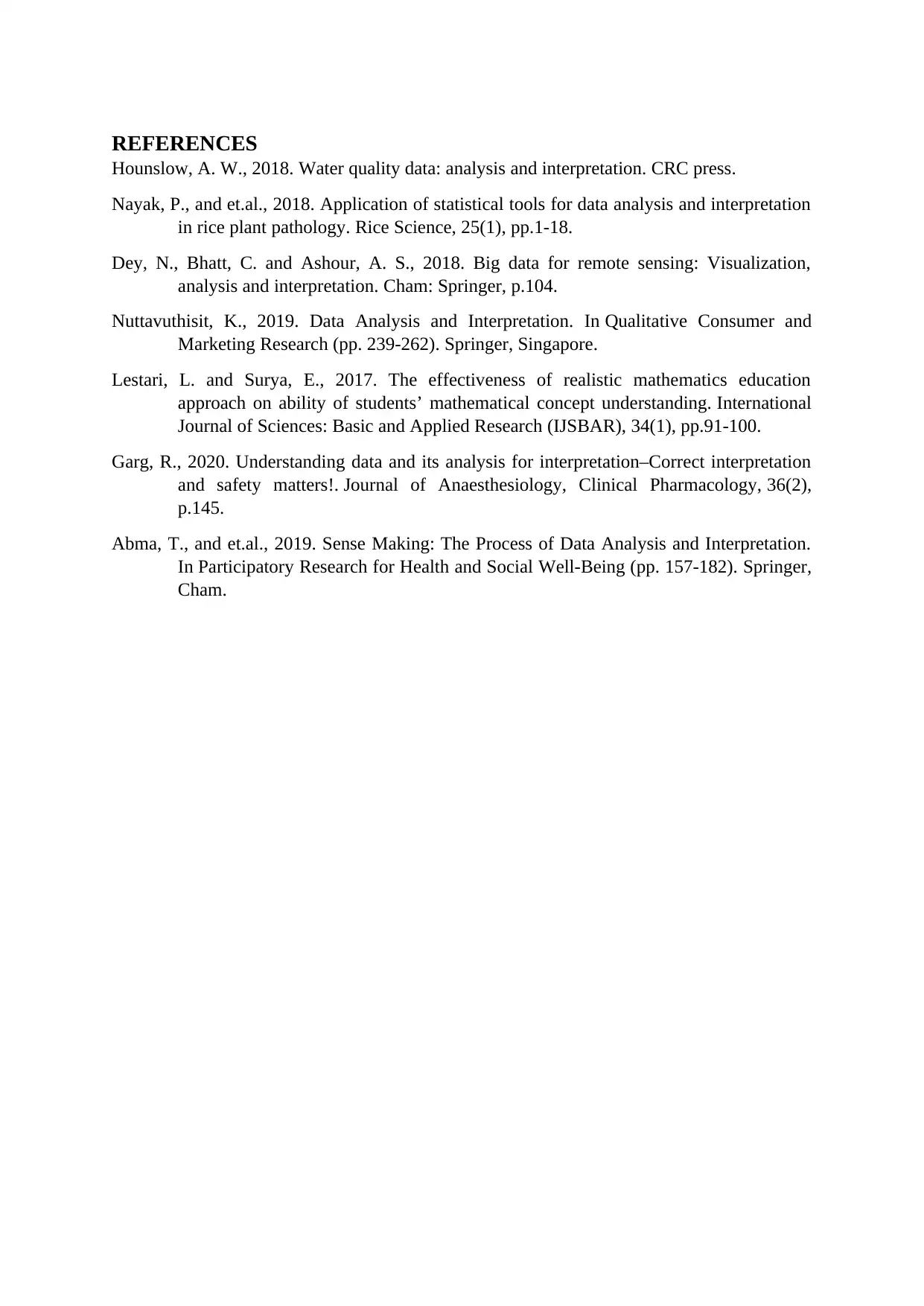
REFERENCES
Hounslow, A. W., 2018. Water quality data: analysis and interpretation. CRC press.
Nayak, P., and et.al., 2018. Application of statistical tools for data analysis and interpretation
in rice plant pathology. Rice Science, 25(1), pp.1-18.
Dey, N., Bhatt, C. and Ashour, A. S., 2018. Big data for remote sensing: Visualization,
analysis and interpretation. Cham: Springer, p.104.
Nuttavuthisit, K., 2019. Data Analysis and Interpretation. In Qualitative Consumer and
Marketing Research (pp. 239-262). Springer, Singapore.
Lestari, L. and Surya, E., 2017. The effectiveness of realistic mathematics education
approach on ability of students’ mathematical concept understanding. International
Journal of Sciences: Basic and Applied Research (IJSBAR), 34(1), pp.91-100.
Garg, R., 2020. Understanding data and its analysis for interpretation–Correct interpretation
and safety matters!. Journal of Anaesthesiology, Clinical Pharmacology, 36(2),
p.145.
Abma, T., and et.al., 2019. Sense Making: The Process of Data Analysis and Interpretation.
In Participatory Research for Health and Social Well-Being (pp. 157-182). Springer,
Cham.
Hounslow, A. W., 2018. Water quality data: analysis and interpretation. CRC press.
Nayak, P., and et.al., 2018. Application of statistical tools for data analysis and interpretation
in rice plant pathology. Rice Science, 25(1), pp.1-18.
Dey, N., Bhatt, C. and Ashour, A. S., 2018. Big data for remote sensing: Visualization,
analysis and interpretation. Cham: Springer, p.104.
Nuttavuthisit, K., 2019. Data Analysis and Interpretation. In Qualitative Consumer and
Marketing Research (pp. 239-262). Springer, Singapore.
Lestari, L. and Surya, E., 2017. The effectiveness of realistic mathematics education
approach on ability of students’ mathematical concept understanding. International
Journal of Sciences: Basic and Applied Research (IJSBAR), 34(1), pp.91-100.
Garg, R., 2020. Understanding data and its analysis for interpretation–Correct interpretation
and safety matters!. Journal of Anaesthesiology, Clinical Pharmacology, 36(2),
p.145.
Abma, T., and et.al., 2019. Sense Making: The Process of Data Analysis and Interpretation.
In Participatory Research for Health and Social Well-Being (pp. 157-182). Springer,
Cham.
1 out of 19
Related Documents
Your All-in-One AI-Powered Toolkit for Academic Success.
+13062052269
info@desklib.com
Available 24*7 on WhatsApp / Email
![[object Object]](/_next/static/media/star-bottom.7253800d.svg)
Unlock your academic potential
© 2024 | Zucol Services PVT LTD | All rights reserved.




